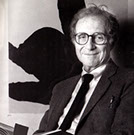
Myron Goldsmith, Architect And Engineer, Is Dead at 77
By DAVID W. DUNLAP
Published: July 17, 1996

Myron Goldsmith, an architect and engineer whose work merged the jewel-like precision of Mies van der Rohe with the greyhound-sleek forms of Pier Luigi Nervi, died on Monday at his home in Wilmette, Ill. He was 77. The cause was heart failure, said his wife, Robin.
A student both of Mies and of Nervi, two of the century's most important architects, Mr. Goldsmith brought their influence to bear on more than 40 projects he designed around the nation for the firm of Skidmore, Owings & Merrill, where he worked from 1955 to 1983, the last 16 years as a general partner in its Chicago office.
Like Mies, Mr. Goldsmith sought to express the structural essence of his buildings in their exteriors, unmasked by ornament. Like Nervi, he designed with the sweeping arcs and long spans made possible by new technologies. The results were almost sculptural: cool, spare, gleaming and hard-edged.
Mr. Goldsmith's best-known work was the McMath-Pierce Solar Telescope Facility of 1962, at the Kitt Peak National Observatory in Arizona, which draws some 100,000 visitors a year.
Crowning a mountaintop near Tucson, the structure looks like the bottom half of the letter K, with a 110-foot tower joined to a shaft that runs 500 feet above and below ground. Both tower and shaft are diamond-shaped, clad in copper panels that are painted white.
Although it appears abstract, the shape is actually a reflection of pure function, since the 32-degree angle of the shaft parallels the axis of the earth's rotation, allowing the viewing angle of the sun to remain constant. And the diamond shape helps reduce wind turbulence on the surface.
Mr. Goldsmith distilled his philosophy in a 1987 monograph: "A building should be built with economy, efficiency, discipline and order."
The work of Miesian architects was widely dismissed in the 1970's and 80's as cold, sterile, repetitive and inhumanly scaled. But Mr. Goldsmith was not singled out for criticism.
Moreover, he was disarming in person, almost an antithesis of his architecture; perpetually rumpled, with a bird's-nest tangle of hair and a shy, soft-spoken demeanor. "He managed with gentleness to exist and prosper in a field that is otherwise eaten up by tigerish egos," said Franz Schulze, an art historian and Mies biographer.
Mr. Goldsmith was born in Chicago and graduated in 1939 from the Illinois Institute of Technology, where he studied under Mies, whose Chicago office he joined in 1946. He worked there until 1953, when he received a Fulbright Grant to study under Nervi at the University of Rome.
His first major projects at Skidmore were two United Air Lines hangars at San Francisco International Airport, one of which used cantilevered steel girders to form a structure large enough to house four DC-8 jetliners.
Other significant projects were the Oakland Alameda County Coliseum of 1966, in California, which includes a circular arena 420 feet in diameter, ringed by a 70-foot-high glass wall behind enormous concrete X-braces; and The Republic newspaper plant in Columbus, Ind., completed in 1971, whose delicate aluminum and glass skin allowed passers-by to view the newsroom and pressroom.
Left unbuilt was the Ruck-a-Chucky Bridge, which was to have spanned the American River in Auburn, Calif., northeast of Sacramento. Recalling somewhat a cat's-cradle on a giant scale, the curving bridge deck would have been suspended from a network of steel cables anchored in the surrounding mountainsides.
Mr. Goldsmith had been a professor of architecture at the Illinois Institute of Technology since 1961. His students' theses in long-span structures and high-rise buildings were frequently prototypes for new engineering systems used in actual projects, like the John Hancock Center in Chicago.
At the time of his death, he was a member of a team organized by the institute to design a 115- to 120-story office, hotel and commercial structure in Seoul for the Hyundai Engineering and Construction Company. The project, known as "Hankang City," may end up as the world's tallest building.
Besides his wife, Mr. Goldsmith is survived by a son, Marc, of Tempe, Ariz.; a daughter, Chandra, of Boston, and a sister, Bernice Colner of Pacific Palisades, Calif.
